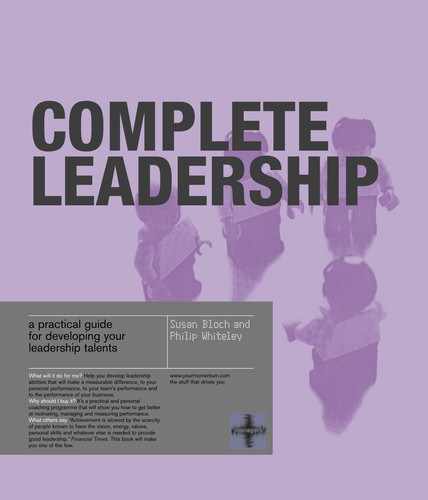
Feedback: some notes on how to engender
continual, two-way feedback with your team
If you’re not used to asking your staff for honest feedback on how
you come across to them and how you lead, it can be difficult to get
started. Of course, 360-degree appraisals have been fashionable in
many corporate circles, but not in all organizations, and there have
been question marks about how reliable the information is from such
exercises in organizations where trust isn’t very high. It has been
documented that requesting such comprehensive, detailed feedback
on managers can be counterproductive in organizations not
accustomed to performance reviews, or where staff are insecure and
therefore have little incentive to be honest. From the individual
manager’s point of view, the thought of uncensored comments
from direct reports can be ‘scary’, even in seasoned and mature
individuals, particularly where there have been organizational
dysfunctions:
‘As with any management tool, 360-degree appraisal depends
upon commitment and upon an atmosphere that is supportive.
Poor morale at the outset or poor implementation can lead to
the use of this valuable tool as a weapon. If an organization is in
trauma then the immediate causes must be dealt with before
trying to use a sophisticated process that depends for its
success upon commitment . . . 360-degree appraisal is also
better suited to an organization where performance appraisal is
already in operation and people are accustomed to the idea of
having their performance assessed. The change arising from
introducing both notions at once can be too much of a shock to
some staff, giving rise to levels of suspicion and hostility that
can be hard to deal with successfully. Sometimes people find
the idea of 360-degree appraisal threatening and imagine that
If you’re not used to asking your staff for honest
feedback on how you come across to them and how
you lead, it can be difficult to get started.
they are going to be told about everything that is wrong with
them.’
28
These observations apply directly to the 360-degree process, in which
feedback is gathered from colleagues, superiors, direct reports and
customers in a systematic way, generally with the help of
questionnaires. Obviously, however, the same general principles and
cautions apply to any structured form of securing feedback.
Nonetheless, such words of advice highlight the importance of
establishing the groundwork for feedback to be obtained; it doesn’t
detract from the power and usefulness of gaining that information
when this is done in a conscientious manner. In this book we argue
that to become a fully complete leader, an accurate perception of how
you lead at the moment is essential. Irrespective of whether your
organization has a formal means of gaining feedback, it’s useful to
develop the habit of gaining at least some impression of how you
come across to others. Obviously, it would be irritating and
confusing for a team if you were to be overly self-conscious and
forever asking, ‘How did I come across in that presentation?’ Your
team needs leadership and it is a mistake to be too open about
feelings and insecurities, as we’ll discuss again in the remaining
chapters. The trick is to try to gain a picture of ourselves. In an earlier
chapter we introduced the metaphor of waiting for a photograph to
come back from the developers. We may believe we were perfectly
groomed as we posed for the photographer, but what will the prints
reveal?
There are even ways of gaining a picture of what our team thinks
of us without asking them. A trusted PA, for example, can be
invaluable. The day after a tricky presentation to the team, you can
ask her (or him), ‘Did that go down well? What are their worries?
Did I allay them? What are they looking for?’ Your PA is likely to be a
trusted confidante, and able to be honest without jeopardizing her
relationship either with you or with the team.
momentum complete leadership chapter seven
139
pages 138 /

Claire Hall-Moore, an associate partner at consultancy group
Accenture, comments:
‘I have asked my direct reports for feedback. Accenture places
a lot of emphasis on leadership development and we have
introduced a leadership self-analysis process that I used to
structure the feedback. One real surprise was that some junior
staff perceptions were very focused on my job title and how that
puts me in a position of power. This can make me, or my role
seem remote to their daily job. That was a surprise to me,
because I did not see myself as being different to the person I
was a couple of years ago (before my promotion). But clearly
because of the change in job title you can be seen as being
somehow different. It is something that I have to keep in mind
so that my team feel that I am approachable.
‘Amongst the positive feedback was the fact that my direct
reports really did value the support that I give them. They saw
me as stretching them; they saw me as having a very strong
“can do” approach, which rubs off on the team in terms of them
saying “we can do this.” It was really useful to understand what I
do to generate this view.’
Through coaching, Claire assessed herself on how well she rated on
three core motives: affiliation, power and achievement. She rated
strongly on all, but especially on achievement (task focus). This
helped her appreciate her own strengths, and recognize that those of
other people might be quite different. One-to-one sessions with her
members of staff, combined with the coaching process, helped
enormously in building up this picture and better enable her to
deploy the talents her team has.
‘One real surprise was that some junior staff
perceptions were very focused on my job title and how
that puts me in a position of power.’

She comments also on how the combination of formal and informal
feedback, getting to know your team, and learning how to handle
people, leads to continual improvement in both self-awareness
and awareness of others. This has a direct effect on business
performance:
‘It is important to demonstrate to your team that they can do
something. If you can give them feedback about how they
thought a project was going to be really hard but they achieved
successful outcomes anyway and get them to think about why,
then you can get them to build on this and do more. You can
give them confidence, and relating this to their work makes this
tangible. Knowing them helps. Being patient helps. Patience is
not my biggest strength – I do get very focused on getting the
job done – so I have to remember to pace myself and remember
that there is always an optimum speed.
‘When I get very focused on getting the job done I also need to
make sure that my communication skills are up to speed. I need
to stop and explain what I want up front and not go with my first
reaction which is to dive in and get the job done. That is where I
have learned to be more patient. If you say, “Just do it,” you risk
getting the wrong result.’
momentum complete leadership chapter seven
141
pages 140 /
Market rating an executive as part of a development
programme
An external measure of effectiveness can be used effectively also. In the example
below, we will see how one firm instituted a development programme for a team, the
results of which were higher performance, less time lost in conflicts, and better
retention. A key feature was to incorporate a way of measuring the effectiveness of
the members. A personnel executive involved in the process takes up the story:
‘We decided to create a shared service centre. This brought together five or six
different businesses that did not have a shared sense of identity or a shared way of

doing business. My contribution to creating this identity was getting the executive
team to work together. They were all strong individuals who had never worked
together before as a team. They were high achievers and they enjoyed the
achievement of running their bit of the business – in a way being “mini-CEOs”.
‘I designed a programme of team-building and individual coaching for each of the
executive team members, including me. When I took the job on some of the very
senior leaders in the firm told me that I had to make this team work better, otherwise
we would not succeed.
‘We used a search and selection agency to give us a market assessment of each of
these senior individuals at the beginning of this team-building. We were able to say:
“Here is an objective assessment about you; how you measure up against other
purchasing directors or marketing directors.” All of them were rated strongly compared
with their peers so we started this process with them knowing that they were not
under threat as individuals.
‘The real test came fairly recently, when we had to disband the team [because of a
reorganization] after two years of building up loyalty, interdependence and personal
trust. A managing director role was created and three of our executive team were
candidates. We decided our appointment would be internal. The worry was that we
would lose the two unsuccessful candidates.
‘Both of those individuals are still with the company. In one case he said he was going
to leave, and got to the point of leaving when we persuaded him to stay. I said, “You
can do other great things here.” I said that knowing his history and knowing him well;
this had come out of that executive team-building, so I knew him and could have that
conversation; and he had got to know himself. The other candidate said, “That’s OK; I
accept the decision. I thought I could have done a better job but I will work for you.”
Anyone who knew him two years ago would not have believed that he would have
been like that – he used to be very volatile and has worked on that. Then he was
offered another opportunity within the firm.’
..................Content has been hidden....................
You can't read the all page of ebook, please click here login for view all page.
